Stimulus-Induced Activation of the Glycoprotein Hormone α-Subunit Promoter in Human Placental Choriocarcinoma Cells: Major Role of a tandem cAMP Response Element
Abstract
1. Introduction
2. Materials and Methods
2.1. Cell Culture and Reagents
2.2. Lentiviral Gene Transfer
2.3. Reporter Gene Assay
2.4. Western Blots
2.5. Statistics
3. Results
3.1. Forskolin Activated Gene Transcription of a Chromatin-Integrated Human Glycoprotein Hormone α-Subunit Promoter-Controlled Reporter Gene in JEG-3 Human Placental Choriocarcinoma Cells
3.2. Nuclear Expression of the Catalytic Subunit of cAMP-Dependent Protein Kinase in JEG-3 Cells Activates the Glycoprotein Hormone α-Subunit Promoter
3.3. Expression of a Constitutively Active Mutant of MAP Kinase Kinase-6 in JEG-3 Cells Leads to Activation of the Glycoprotein Hormone α-Subunit Promoter
3.4. Expression of a Constitutively Active Form of Mitogen-Activated/Extracellular Signal Responsive Kinase Kinase Kinase-1 (MEKK1) Has Only Small Effect on the Promoter Activity of the Glycoprotein Hormone α-Subunit Gene in JEG-3 Cells
3.5. Expression of an Activated Gαq-Coupled Designer Receptor in JEG-3 Cells Induces Glycoprotein Hormone α-Subunit Promoter-Controlled Gene Transcription
3.6. Activation of the Glycoprotein Hormone a-Subunit Promoter in JEG-3 Cells Induced by Forskolin and the Gαq-Coupled Designer Receptor Depends on the Transcription Factor CREB
4. Discussion
5. Conclusions
Author Contributions
Funding
Institutional Review Board Statement
Informed Consent Statement
Data Availability Statement
Acknowledgments
Conflicts of Interest
References
- Kronenberg, H.M.; Melmed, S.; Polonsky, K.S.; Larsen, P.R. Williams Textbook of Endocrinology; Elsevier: Amsterdam, The Netherlands, 2008. [Google Scholar]
- Maurer, R.A.; Kim, K.E.; Schoderbek, W.E.; Roberson, M.S.; Glenn, D.J. Regulation of glycoprotein hormone α-subunit gene expression. Recent Progr. Horm. Res. 1999, 54, 455–484. [Google Scholar] [PubMed]
- Jorgensen, J.S.; Quirk, C.C.; Nilson, J.H. Multiple and overlapping combinatorial codes orchestrate hormonal responsiveness and dictate cell-specific expression of the genes encoding luteinizing hormone. Endocr. Rev. 2004, 25, 521–542. [Google Scholar] [CrossRef] [PubMed]
- Zhao, L.; Bakke, M.; Krimkevich, Y.; Cushman, L.J.; Parlow, A.F.; Camper, S.A.; Parker, K.L. Steroidogenic factor 1 (SF1) is essential for pituitary gonadotrope function. Development 2001, 128, 147–154. [Google Scholar] [CrossRef]
- Raetzman, L.T.; Wheeler, B.S.; Ross, S.A.; Thomas, P.Q.; Camper, S.A. Persistent expression of Notch2 delays gonadotrope differentiation. Mol. Endocrinol. 2006, 20, 2898–2908. [Google Scholar] [CrossRef][Green Version]
- Moore, J.P.; Yang, R.Q.; Winters, S.J. Targeted pituitary overexpression of pititary adenylate-cyclase activating polypeptide alters postnatal sexual maturation in male mice. Endocrinology 2012, 153, 1421–1434. [Google Scholar] [CrossRef]
- Roberson, M.S.; Misra-Press, A.; Laurance, M.E.; Stork, P.J.S.; Maurer, R.A. A role for mitogen-activated protein kinase in mediating activation of the glycoprotein hormone α-subunit promoter. Mol. Cell. Biol. 1995, 15, 3531–3539. [Google Scholar] [CrossRef] [PubMed]
- Tsujii, T.; Attardi, B.; Winters, S.J. Regulation of a-subunit mRNA transcripts by pituitary adenylate cyclase-activating polypeptide (PACAP) in pituitary cell cultures and αT3-1 cells. Mol. Cell. Endocrinol. 1995, 113, 123–130. [Google Scholar] [CrossRef]
- Holdenstock, J.G.; Aylwin, S.J.B.; Burrin, J.M. Calcium and glycoprotein hormone α-subunit gene expression and secretion in α T3-1 gonadotropes. Mol. Endocrinol. 1996, 10, 1308–1317. [Google Scholar]
- Burrin, J.M.; Aylwin, S.J.B.; Holdenstock, J.G.; Sahye, U. Mechanism of action of pituitary adenylate cyclase-activating polypeptide on human glycoprotein hormone α-subunit transcription in αT3-1 gonadotropes. Endocrinology 1998, 139, 1731–1737. [Google Scholar] [CrossRef]
- Fowkes, R.C.; Burch, J.; Murrin, J.M. Stimulation of extracellular signal-regulated kinase by pituitary adenylate cyclase-activating polypeptide in αT3-1 gonadotrophs. J. Endocrinol. 2001, 171, R5–R10. [Google Scholar] [CrossRef][Green Version]
- Fowkes, R.C.; King, P.; Burrin, J.M. Regulation of human glycoprotein hormone α-subunit gene transcription in LβT2 gonadotropes by protein kinase C and extracellular signal-regulated kinase 1/2. Biol. Reprod. 2002, 67, 725–734. [Google Scholar] [CrossRef] [PubMed][Green Version]
- Fowkes, R.C.; Sidhu, K.K.; Sosabowski, J.K.; King, P.; Burrin, J.M. Absence of pititary adenylate cyclase-activating polypeptide-stimulated transcription of the human glycoprotein α-subunit gene in LβT2 gonadotrophs reveals disrupted cAMP-mediated gene transcription. J. Mol. Endocrinol. 2003, 31, 263–278. [Google Scholar] [CrossRef] [PubMed][Green Version]
- Harris, D.; Chuderland, D.; Bonfil, D.; Kraus, S.; Seger, R.; Naor, Z. Extracellular signal-regulated kinase and c-Src, but not Jun N-terminal kinase, are involved in basal and gonadotropin-releasing hormone-stimulated activity of the glycoprotein hormone α-subunit promoter. Endocrinology 2003, 144, 612–622. [Google Scholar] [CrossRef] [PubMed]
- Xie, J.; Bliss, S.P.; Nett, T.M.; Ebersole, B.J.; Sealfon, S.C.; Roberson, M.S. Transcript profiling of immediate early genes reveals a unique role for activating transcription factor 3 in mediating activation of the glycoprotein hormone α-subunit promoter by gonadotropin-releasing hormone. Mol. Endocrinol. 2005, 19, 2624–2638. [Google Scholar] [CrossRef] [PubMed][Green Version]
- Pnueli, L.; Luo, M.; Wang, S.; Naor, Z.; Melamed, P. Calcineurin mediates the gonadotropin-releasing hormone effect on expression of both subunits of the follicle-stimulating hormone through distinct mechanism. Mol. Cell. Biol. 2011, 31, 5023–5036. [Google Scholar] [CrossRef] [PubMed][Green Version]
- Haj, M.; Wijeweera, A.; Rudnizky, S.; Taunton, J.; Pnueli, L.; Melamed, P. Mitogen- and stress-activated protein kinase 1 is required for gonadotropin-releasing hormone-mediated activation of gonadotropin α-subunit expression. J. Biol. Chem. 2017, 292, 20720–20731. [Google Scholar] [CrossRef] [PubMed]
- Desai, B.J.; Burrin, J.M. PACAP-38 positively regulates glycoprotein hormone alpha-gene expression in placental cells. Mol. Cell. Endocrinol. 1994, 99, 31–37. [Google Scholar] [CrossRef]
- Matsumoto, K.; Yamamoto, T.; Kurachi, H.; Nishio, Y.; Takeda, T.; Homma, H.; Morishige, K.-i.; Miyake, A.; Murata, Y. Human chorionic gonadotropin-a-gene is transcriptionally activated by epidermal growth factor through cAMP response element in trophoblast cells. J. Biol. Chem. 1998, 273, 7800–7806. [Google Scholar] [CrossRef]
- Roberson, M.S.; Ban, M.; Zhang, T.; Mulvaney, J.M. Role of the cyclic AMP response element binding complex and activation of mitogen-activated protein kinases in synergistic activation of the glycoprotein hormone α subunit gene by epidermal growth factor and forskolin. Mol. Cell. Biol. 2000, 20, 3331–3344. [Google Scholar] [CrossRef]
- Akerblom, I.E.; Slater, E.P.; Beato, M.; Baxter, J.D.; Mellon, P.L. Negative regulation by glucocorticoids through interference with cAMP responsive enhancer. Science 1988, 241, 350–353. [Google Scholar] [CrossRef]
- Chatterjee, V.K.; Lee, J.K.; Rentoumis, A.; Jameson, J.L. Negative regulation of the thyroid-stimulating hormone alpha gene by thyroid hormone: Receptor interaction adjacent to the TATA box. Proc. Natl. Acad. Sci. USA 1989, 86, 9114–9118. [Google Scholar] [CrossRef] [PubMed]
- Chatterjee, V.K.; Madison, L.D.; Mayo, S.; Jameson, J.L. Repression of the human glycoprotein hormone alpha-subunit gene by glucocorticoids: Evidence for receptor interactions with limiting transcriptional activators. Mol. Endocrinol. 1991, 5, 100–110. [Google Scholar] [CrossRef] [PubMed][Green Version]
- Roberson, M.S.; Zhang, T.; Li, H.L.; Mulvaney, J.M. Activation of the p38 mitogen-activated protein kinase pathway by gonadotropin-releasing hormone. Endocrinology 1999, 140, 1310–1318. [Google Scholar] [CrossRef] [PubMed][Green Version]
- Heckert, L.L.; Schultz, K.; Nilson, J.H. The cAMP response element of the α subunit gene bind similar proteins in trophoblasts and gonadotropes but have distinct functional sequence requirements. J. Biol. Chem. 1996, 271, 31650–31656. [Google Scholar] [CrossRef] [PubMed]
- Jeong, S.; Stein, A. Micrococcal nuclease digestion of nuclei reveals extended nucleosome ladders having anomalous DNA lengths for chromatin assembled on non- replicating plasmids in transfected cells. Nucleic Acids Res. 1994, 22, 370–375. [Google Scholar] [CrossRef] [PubMed]
- Smith, C.L.; Hager, G.L. Transcriptional regulation of mammalian genes in vivo. J. Biol. Chem. 1997, 272, 27493–27496. [Google Scholar] [CrossRef] [PubMed]
- Kaufmann, A.; Keim, A.; Thiel, G. Regulation of immediate-early gene transcription following activation of Gαq-coupled designer receptors. J. Cell. Biochem. 2013, 114, 681–696. [Google Scholar] [CrossRef]
- Mayer, S.I.; Dexheimer, V.; Nishida, E.; Kitajima, S.; Thiel, G. Expression of the transcriptional represser ATF3 in gonadotrophs is regulated by Egr-1, CREB, and ATF2 after gonadotropin-releasing hormone receptor stimulation. Endocrinology 2008, 149, 6311–6325. [Google Scholar] [CrossRef] [PubMed]
- King, A.; Thomas, L.; Bischof, P. Cell culture models of trophoblast II: Trophoblast cell lines—A workshop report. Placenta 2000, 14, S113–S119. [Google Scholar] [CrossRef]
- Poloski, E.; Oettel, A.; Ehrentraut, S.; Luley, L.; Costa, S.-D.; Zenclussen, A.C.; Schumacher, A. JEG-3 trophoblast cells producing human chorionic gonadotropin promote conversion of human CD4+FOXP3− T cells into CD4+FOXP3+ regulatory T cells and foster T cell suppressive activity. Biol. Reprod. 2016, 94, 106. [Google Scholar] [CrossRef]
- Spohn, D.; Rössler, O.G.; Philipp, S.E.; Raubuch, M.; Kitajima, S.; Griesemer, D.; Hoth, M.; Thiel, G. Thapsigargin induces expression of activating transcription factor 3 in human keratinocytes involving Ca2+ ions and c-Jun N-terminal protein kinase. Mol. Pharmacol. 2010, 78, 865–876. [Google Scholar] [CrossRef] [PubMed]
- Thiel, G.; Al Sarraj, J.; Vinson, C.; Stefano, L.; Bach, K. Role of basic region leucine zipper transcription factors CREB, CREB2, activating transcription factor 2 and CAAT/enhancer binding protein alpha in cyclic AMP response element-mediated transcription. J. Neurochem. 2005, 92, 321–336. [Google Scholar] [CrossRef] [PubMed]
- Rössler, O.G.; Thiel, O.G. Regulation of gene transcription following stimulation of Gαq-coupled designer receptors. In Designer Receptors Exclusively Activated by Designer Drugs; Thiel, G., Ed.; Springer: New York, NY, USA, 2015; Volume 108, pp. 49–60. [Google Scholar]
- Cibelli, G.; Jüngling, S.; Schoch, S.; Gerdes, H.H.; Thiel, G. Identification of a functional cAMP response element in the secretogranin II gene. Eur. J. Biochem. 1996, 236, 171–179. [Google Scholar] [CrossRef]
- Drust, D.S.; Troccoli, N.M.; Jameson, J.L. Binding specificity of cyclic adenosine 3’, 5’-monophosphate-responsive element (CRE)-binding proteins and activating transcription factors to naturally occuring CRE sequence variants. Mol. Endocrinol. 1991, 5, 1541–1551. [Google Scholar] [CrossRef][Green Version]
- Cheng, K.W.; Leung, P.C.K. Human gonadotropin-activated cAMP-pathway regulates human placental GnRH receptor gene transcription in choriocarcinoma JEG-3 cells. J. Clin. Endocrinol. Metab. 2002, 87, 3291–3299. [Google Scholar] [CrossRef][Green Version]
- Lee, K. Epac: New emerging cAMP-binding protein. BMB Rep. 2012, 54, 149–156. [Google Scholar] [CrossRef]
- Harootunian, A.T.; Adams, S.R.; Wen, W.; Meinkoth, J.L.; Taylor, S.S.; Tsien, R.Y. Movement of the free catalytic subunit of cAMP-dependent protein kinase into and out of the nucleus can be explained by diffusion. Mol. Biol. Cell. 1993, 4, 993–1002. [Google Scholar] [CrossRef] [PubMed]
- Tan, Y.; Xu, Q.; Li, Y.; Mao, X.; Zhang, K. Crosstalk between the p38 and TGF-β signaling pathways through TβRI, TβRII and Smad3 expression in placental choriocarcinoma JEG-3 cells. Oncol. Lett. 2014, 8, 1307–1311. [Google Scholar] [CrossRef]
- Canovas, B.; Nebreda, A.R. Diversity and versatility of p38 kinase signalling in health and disease. Nat. Rev. Mol. Cell Biol. 2021, 22, 346–366. [Google Scholar] [CrossRef]
- Lindaman, L.L.; Yeh, D.M.; Xie, C.; Breen, K.M.; Coss, D. Phosphorylation of ATF2 and interaction with NFY induces c-Jun in the gonadotrope. Mol. Cell. Endocrinol. 2013, 365, 316–326. [Google Scholar] [CrossRef][Green Version]
- Raingeaud, J.; Whitmarsh, A.J.; Barrett, T.; Derijard, B.; Davis, R.J. MKK3- and MKK6-regulated gene expression is mediated by the p38 mitogen-activated protein kinase signal transduction pathway. Mol. Cell. Biol. 1996, 16, 1247–1255. [Google Scholar] [CrossRef] [PubMed]
- Dalhäusser, A.K.; Rössler, O.G.; Thiel, G. Regulation of c-Fos transcription by stimulus-responsive protein kinases. Gene 2022, 821, 146284. [Google Scholar] [CrossRef] [PubMed]
- Yujiri, T.; Sather, S.; Fanger, G.R.; Johnson, G.L. Role of MEKK1 in cell survival and activation of JNK and ERK pathways defined by targeted gene disruption. Science 1998, 282, 1911–1914. [Google Scholar] [CrossRef] [PubMed]
- Xia, Y.; Makris, C.; Su, B.; Li, E.; Yang, J.; Nemerow, G.R.; Karin, M. MEK kinase 1 is critically required for c-Jun N-terminal kinase activation by proinflammatory stimuli and growth factor-induced cell migration. Proc. Natl. Acad. Sci. USA 2000, 97, 5243–5248. [Google Scholar] [CrossRef]
- Thiel, G.; Kaufmann, A.; Rössler, O.G. G-protein-coupled designer receptors—New chemical-genetic tools for signal transduction research. Biol. Chem. 2013, 394, 1615–1622. [Google Scholar] [CrossRef]
- Urban, D.J.; Roth, B.L. DREADDs (designer receptors exclusively activated by designer drugs): Chemogenetic tools with therapeutic utility. Annu. Rev. Pharmacol. Toxicol. 2015, 55, 399–417. [Google Scholar] [CrossRef] [PubMed]
- Campain, J.A.; Eudy, J.D.; Cox, G.S. Permissive effect of cyclic AMP and cycloheximide for induction by sodium butyrate of the glycoprotein hormone α-subunit gene in choriocarcinoma cells. Cell Growth Differ. 1994, 5, 827–838. [Google Scholar]
- Newman, J.R.S.; Keating, A.E. Comprehensive identification of human bZIP interactions with coiled-coil arrays. Science 2003, 300, 2097–2101. [Google Scholar] [CrossRef] [PubMed]
- Hamernik, D.L.; Crowder, M.E.; Nilson, J.H.; Nett, T.M. Measurement of messenger ribonucleic acid for luteinizing hormone β-subunit, α-subunit, growth hormone, and prolactin after hypothalamic pituitary disconnection in ovariectomized ewes. Endocrinology 1986, 119, 2704–2710. [Google Scholar] [CrossRef]
- Vaqué, J.P.; Dorsam, R.T.; Feng, X.; Iglesias-Bartolome, R.; Forsthoefel, D.J.; Chen, Q.; Debant, A.; Seeger, M.A.; Ksander, B.R.; Teramoto, H.; et al. A genome-wide RNAi screen reveals a trio-regulated Rho GTPase circuitry transducing mitogenic signals initiated by G protein-coupled receptors. Mol. Cell 2013, 49, 94–108. [Google Scholar] [CrossRef]
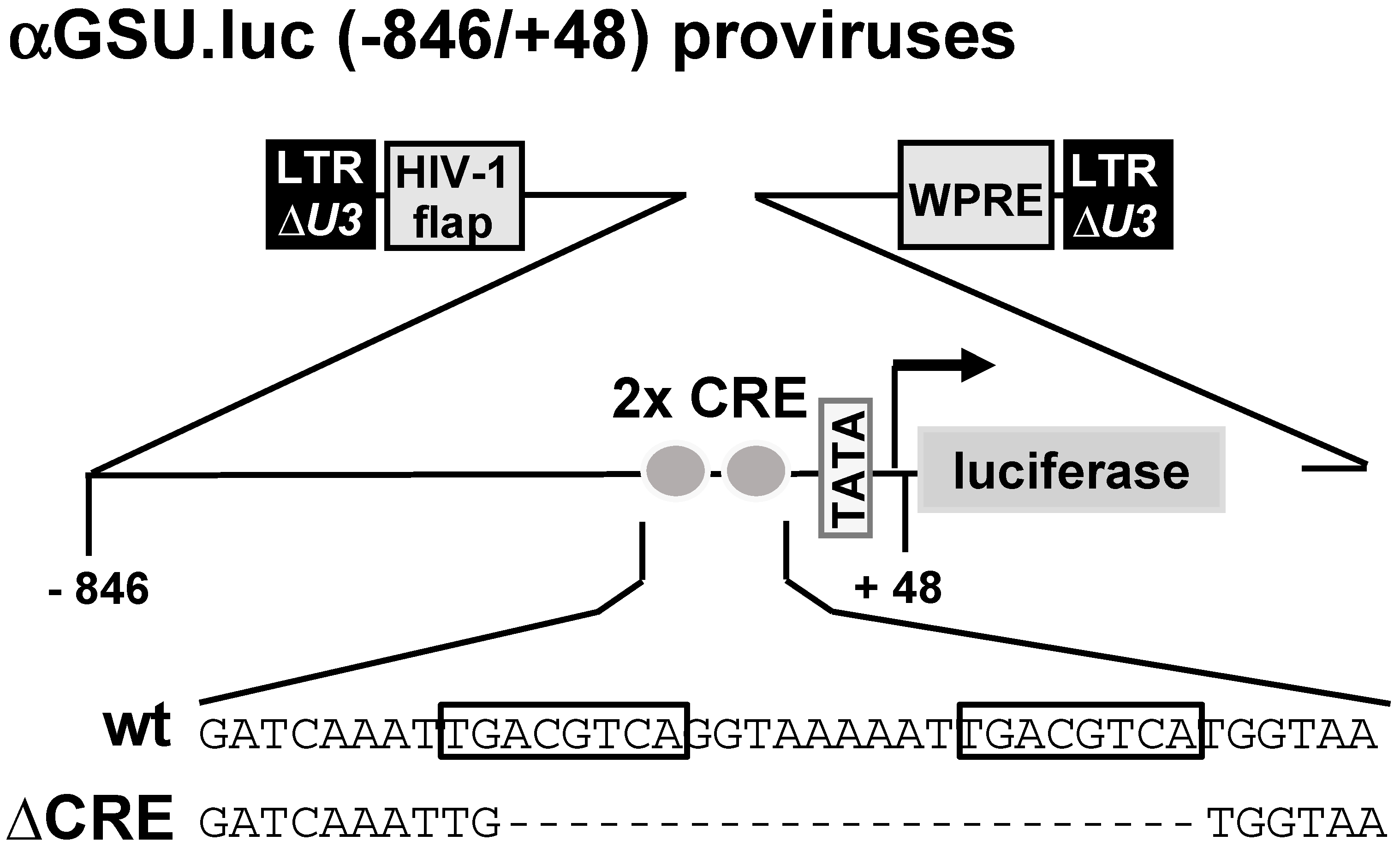
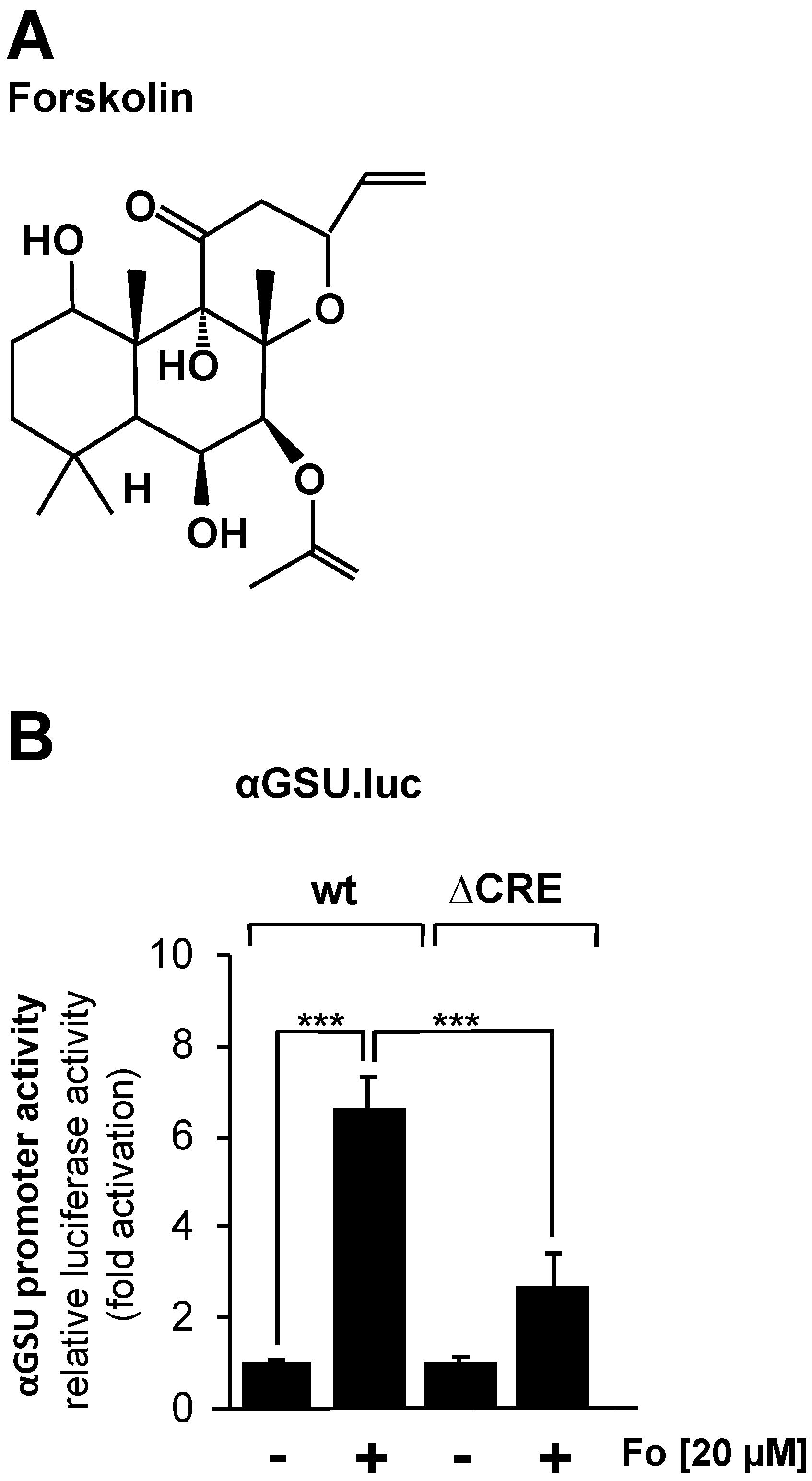
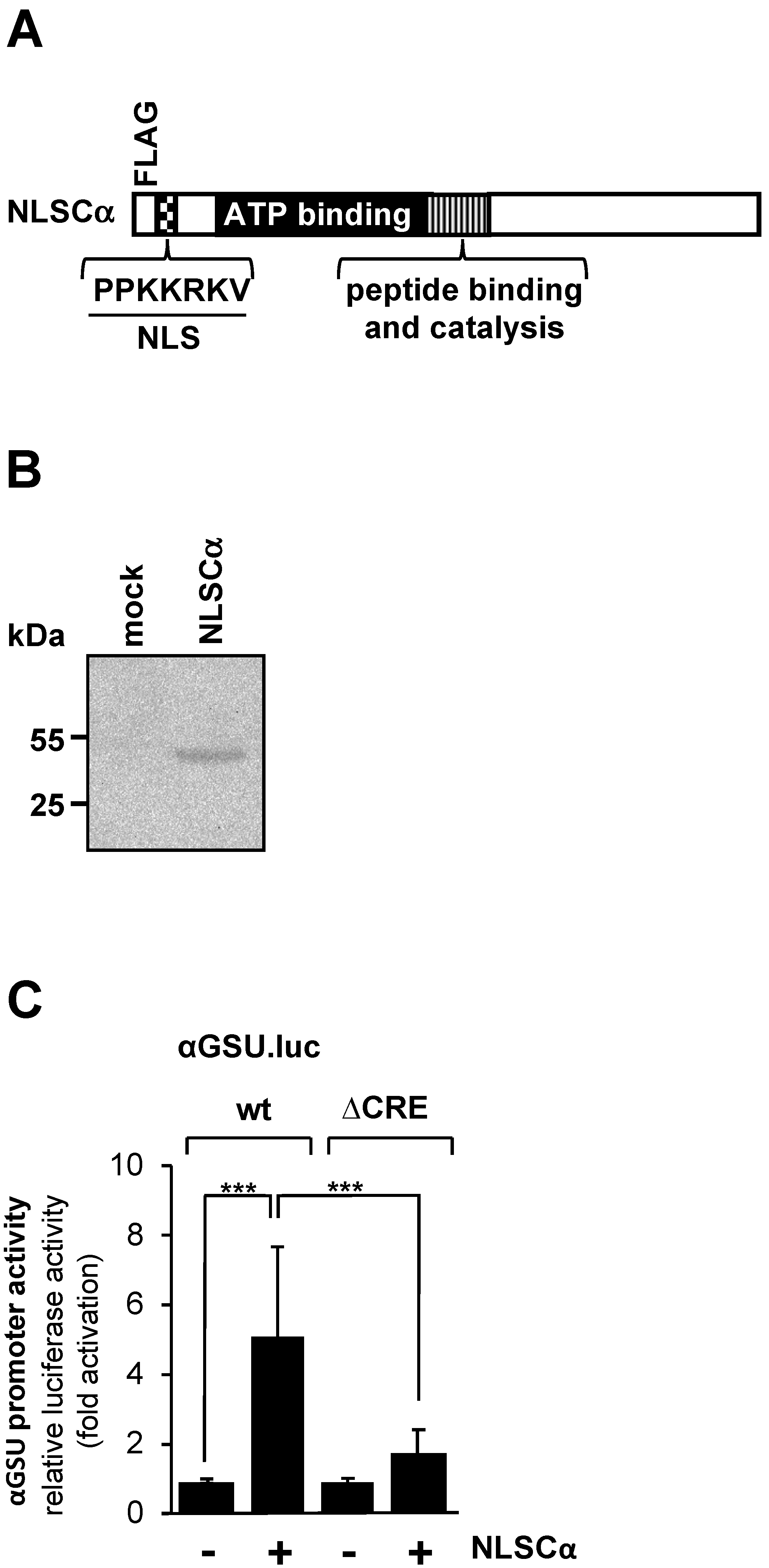

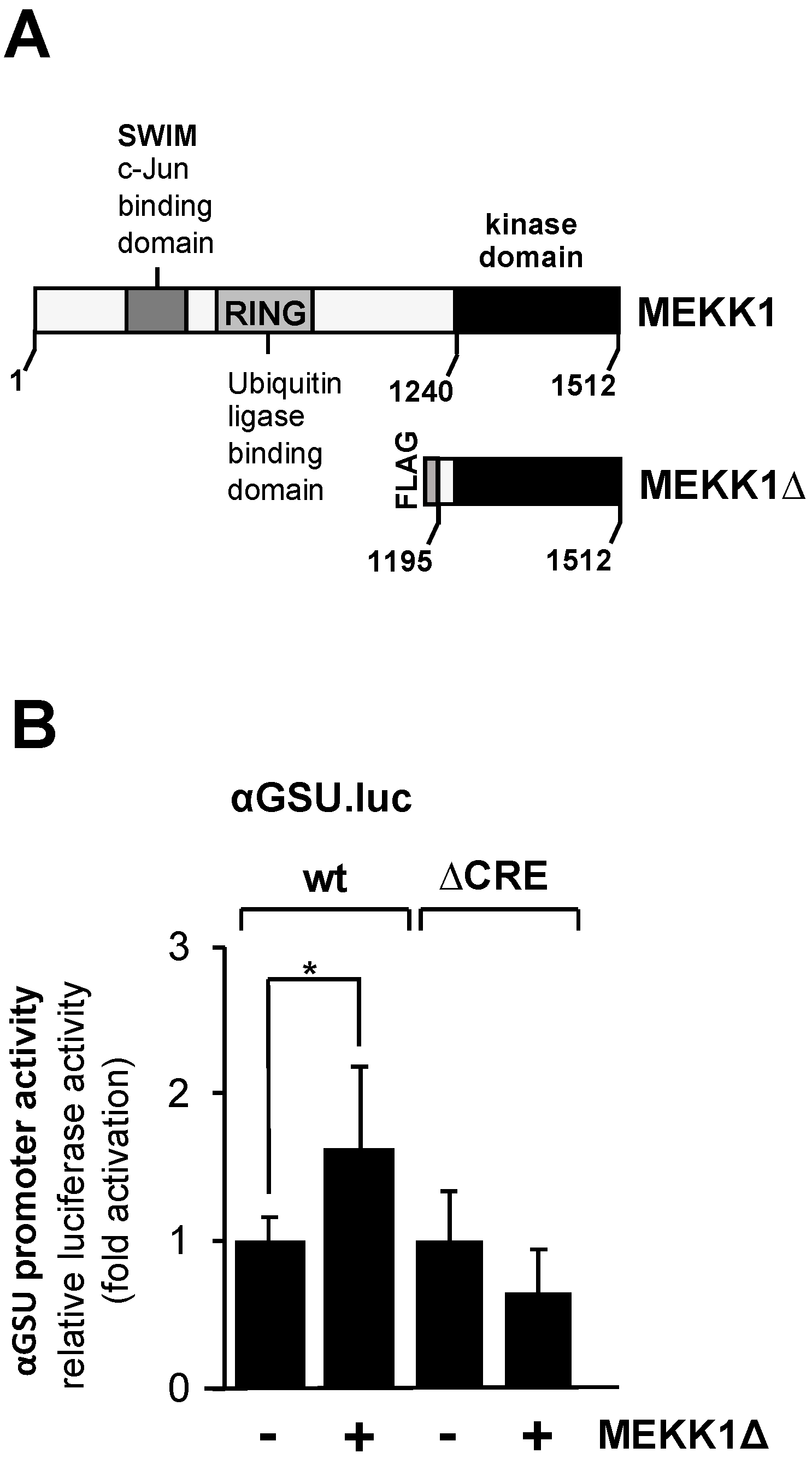
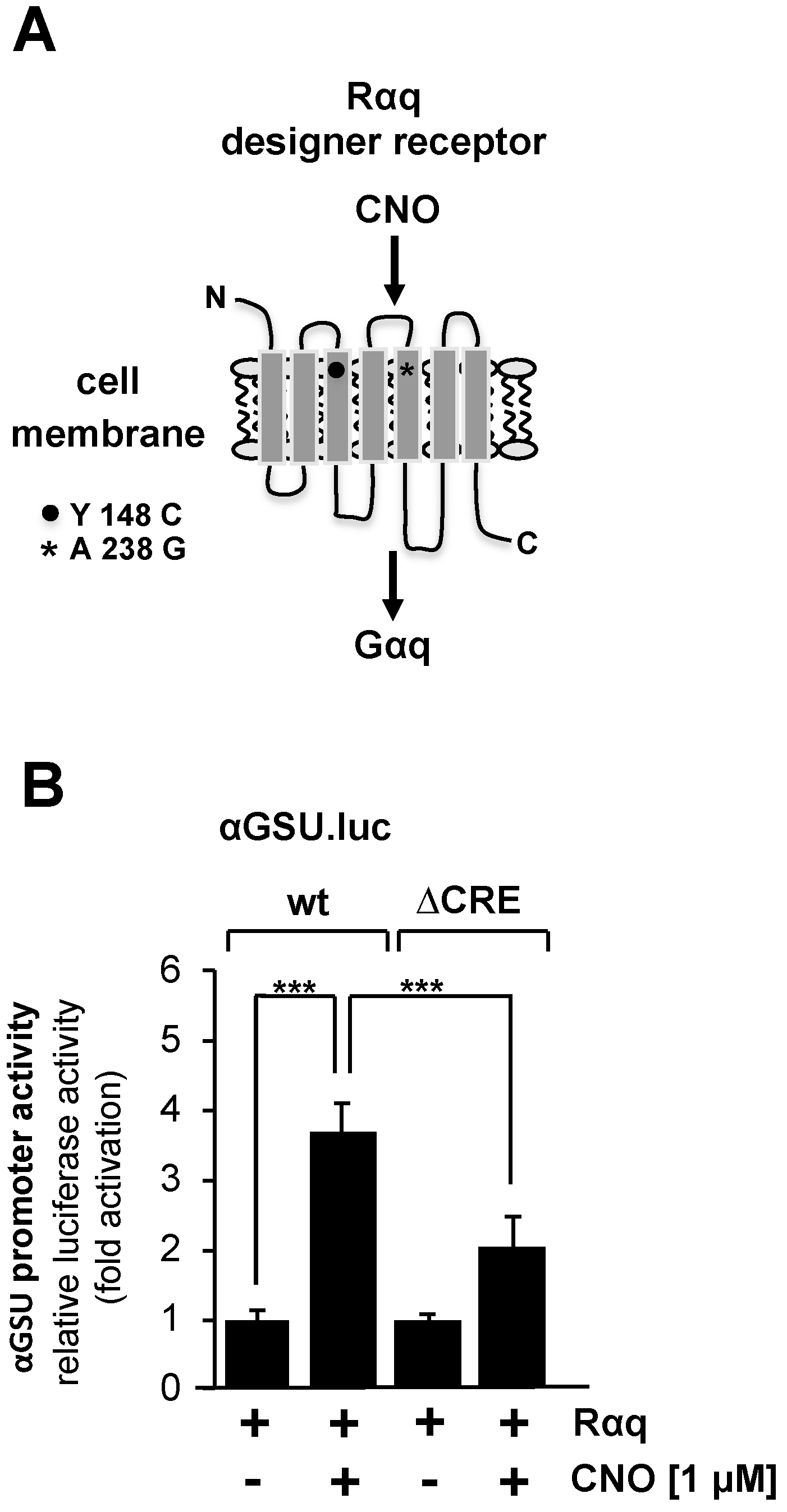

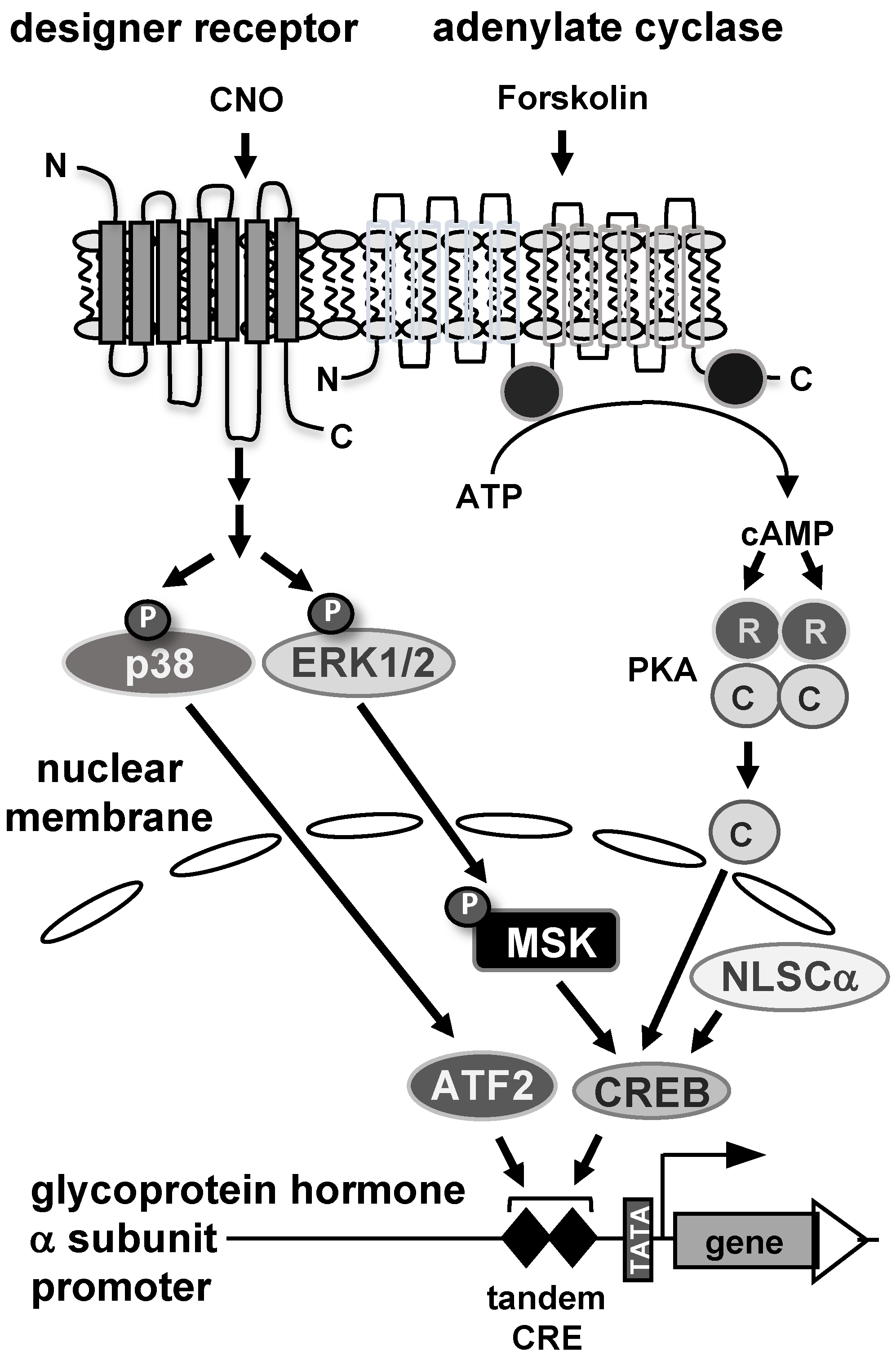
Disclaimer/Publisher’s Note: The statements, opinions and data contained in all publications are solely those of the individual author(s) and contributor(s) and not of MDPI and/or the editor(s). MDPI and/or the editor(s) disclaim responsibility for any injury to people or property resulting from any ideas, methods, instructions or products referred to in the content. |
© 2024 by the authors. Licensee MDPI, Basel, Switzerland. This article is an open access article distributed under the terms and conditions of the Creative Commons Attribution (CC BY) license (https://creativecommons.org/licenses/by/4.0/).
Share and Cite
Bürvenich, L.; Rössler, O.G.; Thiel, G. Stimulus-Induced Activation of the Glycoprotein Hormone α-Subunit Promoter in Human Placental Choriocarcinoma Cells: Major Role of a tandem cAMP Response Element. Curr. Issues Mol. Biol. 2024, 46, 3218-3235. https://doi.org/10.3390/cimb46040202
Bürvenich L, Rössler OG, Thiel G. Stimulus-Induced Activation of the Glycoprotein Hormone α-Subunit Promoter in Human Placental Choriocarcinoma Cells: Major Role of a tandem cAMP Response Element. Current Issues in Molecular Biology. 2024; 46(4):3218-3235. https://doi.org/10.3390/cimb46040202
Chicago/Turabian StyleBürvenich, Lars, Oliver G. Rössler, and Gerald Thiel. 2024. "Stimulus-Induced Activation of the Glycoprotein Hormone α-Subunit Promoter in Human Placental Choriocarcinoma Cells: Major Role of a tandem cAMP Response Element" Current Issues in Molecular Biology 46, no. 4: 3218-3235. https://doi.org/10.3390/cimb46040202
APA StyleBürvenich, L., Rössler, O. G., & Thiel, G. (2024). Stimulus-Induced Activation of the Glycoprotein Hormone α-Subunit Promoter in Human Placental Choriocarcinoma Cells: Major Role of a tandem cAMP Response Element. Current Issues in Molecular Biology, 46(4), 3218-3235. https://doi.org/10.3390/cimb46040202




